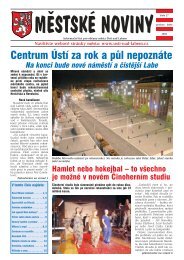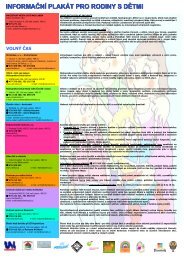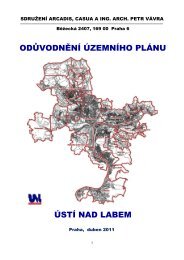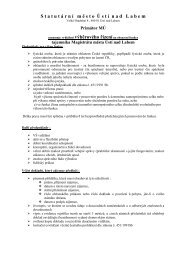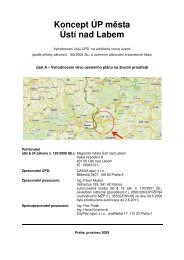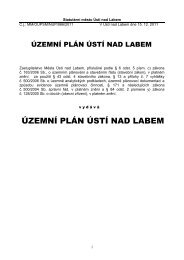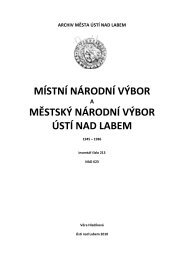Historie a památky města Ústí nad Labem History and monuments of ...
Historie a památky města Ústí nad Labem History and monuments of ...
Historie a památky města Ústí nad Labem History and monuments of ...
Erfolgreiche ePaper selbst erstellen
Machen Sie aus Ihren PDF Publikationen ein blätterbares Flipbook mit unserer einzigartigen Google optimierten e-Paper Software.
CZ ENG DE<br />
plexní přestavbě původního kostela, na které se podílel<br />
významný litoměřický barokní stavitel O. Broggio.<br />
Ke stavbě dnešního konventu došlo pravděpodobně současně<br />
s výstavbou kostela v první polovině 18. století s použitím starších<br />
budov. Konvent byl však již roku 1785 na základě císařské<br />
rezoluce zrušen, na žádost <strong>města</strong> byl však v druhé polovině 19.<br />
století obnoven. Po uzavření kláštera a kostela v roce 1950 byly<br />
tyto prostory v šedesátých letech 20. století adaptovány na<br />
městskou výstavní a koncertní síň Bedřicha Smetany. Původní<br />
využití se těmto prostorám vrátilo teprve po listopadovém převratu<br />
v roce 1989, s tím, že kostel dále slouží především výstavním<br />
účelům.<br />
57<br />
Arnošt Schösser, introduced Dominican<br />
monks to the church. The current<br />
appearance <strong>of</strong> the church dates<br />
back to 1704 - 1734, when the original<br />
structure was completely rebuilt<br />
with the participation <strong>of</strong> renowned<br />
Baroque builder O. Broggio from Litoměřice.<br />
The current convent was presumably built simultaneously with<br />
the church in the early 18th closed down as early as in 1785,<br />
upon an imperial resolution. Upon the request <strong>of</strong> the town, the<br />
convent resumed its activities in the late 19th century. After the<br />
convent <strong>and</strong> the church were closed down in 1950, the premises<br />
were converted into the city exhibition <strong>and</strong> concert hall <strong>of</strong><br />
Bedřich Smetana in the 1960´s. The church could not be used<br />
for its original purpose until after the November velvet revolution<br />
in 1989, <strong>and</strong> now it is mostly used for exhibitions.<br />
Gestalt bis zum 17. Jahrhundert,<br />
als der Aussiger<br />
Primas, ein Gegenreformator<br />
und eifriger Katholik<br />
Jan Arnošt Schösser<br />
dominikanische Mönche<br />
zur Kirche brachte. Die<br />
heutige Kirche wurde in<br />
den Jahren 1704 – 1734<br />
gebaut, als ein vollständiger<br />
Umbau der ursprünglichen<br />
Kirche erfolgte,<br />
an welchem der<br />
bedeutende Leitmeritzer<br />
Barockbauer O. Broggio<br />
teilnahm.<br />
Der heutige Konvent<br />
wurde wahrscheinlich<br />
gleichzeitig mit der Kirche<br />
in der ersten Hälfte<br />
des 18. Jahrhunderts<br />
gebaut, wobei ältere<br />
Gebäude benutzt wurden.<br />
Der Konvent wurde<br />
allerdings bereits im<br />
Jahre 1785 aufgrunde<br />
einer Kaiserresolution<br />
aufgelöst, jedoch auf<br />
Wunsch der Stadt wurde<br />
58<br />
er in der zweiten Hälfte<br />
des 19. Jahrhunderts<br />
wieder erneuert. Nach dem Schließen des Klosters und der Kirche<br />
im Jahre 1950 wurde dieses Gelände in den 60er Jahren<br />
des 20. Jahrhunderts für die Bedřich Smetana Ausstellungsund<br />
Konzerthalle angepasst. Die ursprüngliche Nutzung kehrte<br />
in dieses Gelände erst nach der Wende im November 1989<br />
zurück, und zwar so, dass die Kirche weiterhin vor allem für<br />
Ausstellungszwecke dient.<br />
75



